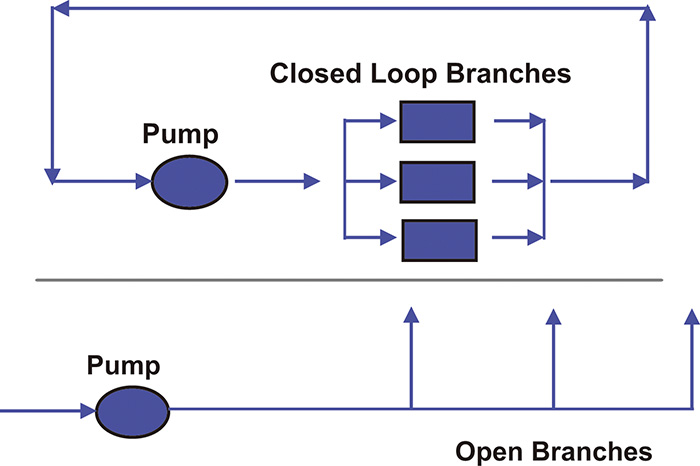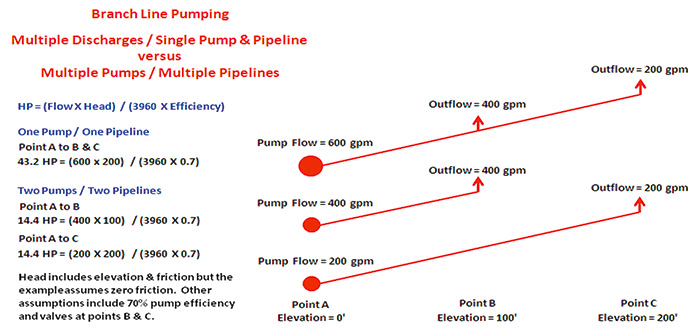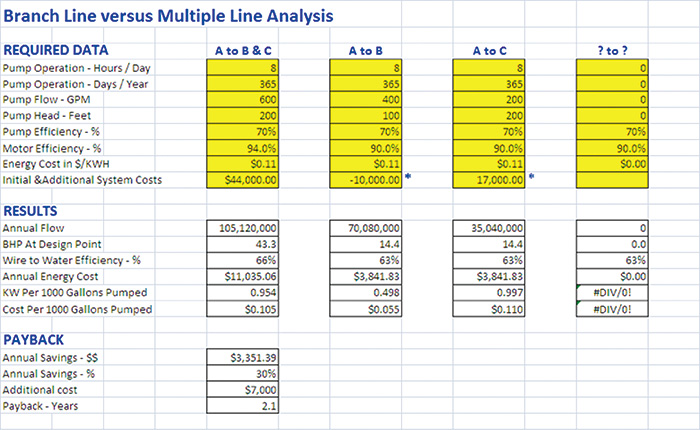Pumps & Systems, February 2013
Branch-line pumping applications abound throughout the pumping industry. These systems consist of a pump (or pumps) discharging into a single line that feeds a network of individual piping segments. Branch-line systems can be closed-loop or open-ended.
Closed-Loop & Open-Ended Systems
Figure 1 illustrates these two configurations. Closed-loop systems are often seen in heat exchange applications in commercial and industrial processes. The most common example of an open-ended system is the water piping in a typical home. The hot and cold water pipes branch out to the kitchen, laundry room and bathrooms. Many high-rise buildings use booster pumps that feed a vertical riser with open branches to each floor. Industrial applications use open-ended systems to distribute fluids to various locations within a plant.
Open-ended branch lines can be effective in moving water from a single source to multiple points of use. They can also be efficient as long as friction is the main component of total dynamic head (TDH). However, as elevation of the downstream branches increases, the total cost of pumping can increase quickly.
When a pump supplies multiple branches simultaneously, its flow will be the sum of the branch flows. If all the branches are at the same elevation, the pump head will be that elevation plus the sum of the friction heads between the pump and the branch outfalls. If, however, the branches are at different elevations, the head required will be the sum of the friction heads and the elevation head of the highest branch. Even though the highest elevation may require a small percentage of the pump flow, its head requirement will dictate the operating pressure of the pump and, therefore, its required horsepower.
A water pressure booster system is a good example of how the upper elevation branches influence pressure and the cost of pumping. Picture a 30-story building with a booster system supplying additional pressure to Floors 4 through 30. Floors 1 through 3 use street pressure (140 feet). The system must be sized to meet the flow required by all the floors and the pressure required at the 30th floor. Although the lower floors require little additional pressure, their branch lines will see far more pressure than the branch on the 30th floor. If the booster system is to provide street pressure on the 30th floor, it must provide about 300 feet of head to the system. That would mean that the 4th floor would see a branch pressure of about 410 feet. These individual floor pressures can be easily reduced with a pressure reducing valve (PRV), but the total energy consumption of the system will often dictate a different approach. High-rise buildings can also be designed with multiple zones that use multiple riser pipes and multiple booster systems that can provide pressure to the different floors far more efficiently. Several alternatives are also available to the designer.

Figure 1. Closed-loop (top) and open-ended (bottom) systems
Example
Figure 2 is an example from my “Branch Line Pumping Alternatives” spreadsheet. It allows a user or designer to compare a standard branch-line pumping system with several alternative designs and calculate the potential cost savings of those alternative designs. It is an evaluation tool—not a design tool.
In this example, a single pump at Point A supplies two branches at Points B and C. The system requires a pump that can provide 600 gallons per minute (gpm) at 200 feet of TDH. Point B is at an elevation of 100 feet and has an outflow of 400 gpm. Point C is 100 feet higher and has an outflow of 200 gpm. This is illustrated by the upper red, angled line. To meet these conditions, 43.2 horsepower (HP) is required.
An alternative to a single line with two branches is two separate lines supplied by individual pumps. These are illustrated by the two lower, angled, red lines. The first line delivers 400 gpm from Point A to Point B at a head of 100 feet and requires 14.4 HP. The second line delivers 200 gpm from Point A to Point C at a head of 200 feet and also requires 14.4 HP. The total HP for the two individual lines is just 66 percent of the single branch line, so significant electrical savings are available. Will the electrical savings make the two-line system cost effective?

Figure 2. “Branch Line Pumping Alternatives” spreadsheet
Figure 3 is the calculator portion of the spreadsheet, and it compares the variables offered by these two alternative designs. The required data is entered into the yellow cells. The column on the left is the branch-line circuit, and the two in the middle are the individual lines from A to B and A to C.
The required data include run time, flow, head (including friction), efficiency, electrical cost and initial & additional system costs. Although not shown in Figure 3, a set of instructions resides at the bottom of the sheet.
Column 1 shows that the total cost of the branch-line system is $44,000. Column 2 shows a cost reduction of $10,000 due to the smaller pump required for flow from Point A to B. Column 3 shows an additional cost of $17,000.00 for the line from Point A to C. This amount represents the cost of the additional piping required from A to B plus the additional pump and controls.
The “Results” columns show the calculated results for the two alternatives. These include annual flow, brake horsepower required, wire-to-water efficiency and total energy costs. The “Payback” portion computes the overall cost increase and energy savings and uses them to compute the payback period. In this example, the two-line, two-pump alternative will pay for itself in a little more than two years. The potential for increased maintenance costs is not included in this analysis but could be entered in the “Additional System Costs” in columns 2 and 3.
The calculator is not limited to single-point branches as shown in this example. The “A to B” column could also be a branch zone that feeds multiple branches within the zone. If more than three branches or zones are required, more columns can be added to the spreadsheet.
Next month, we will look at another alternative to the single-line, single-pump, open-branch design. P&S

Figure 3. Calculator portion of the spreadsheet

